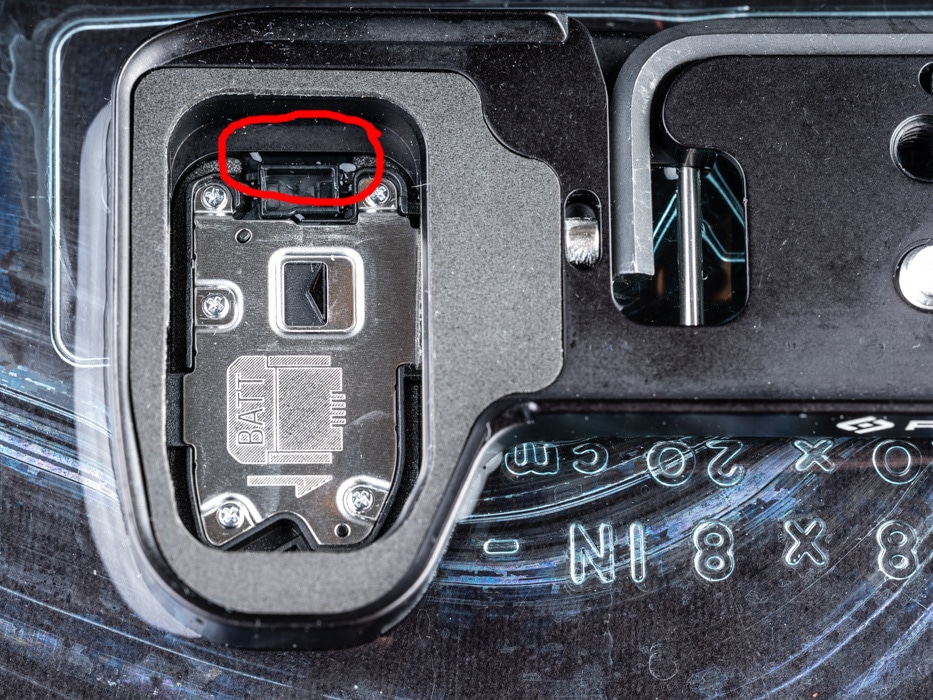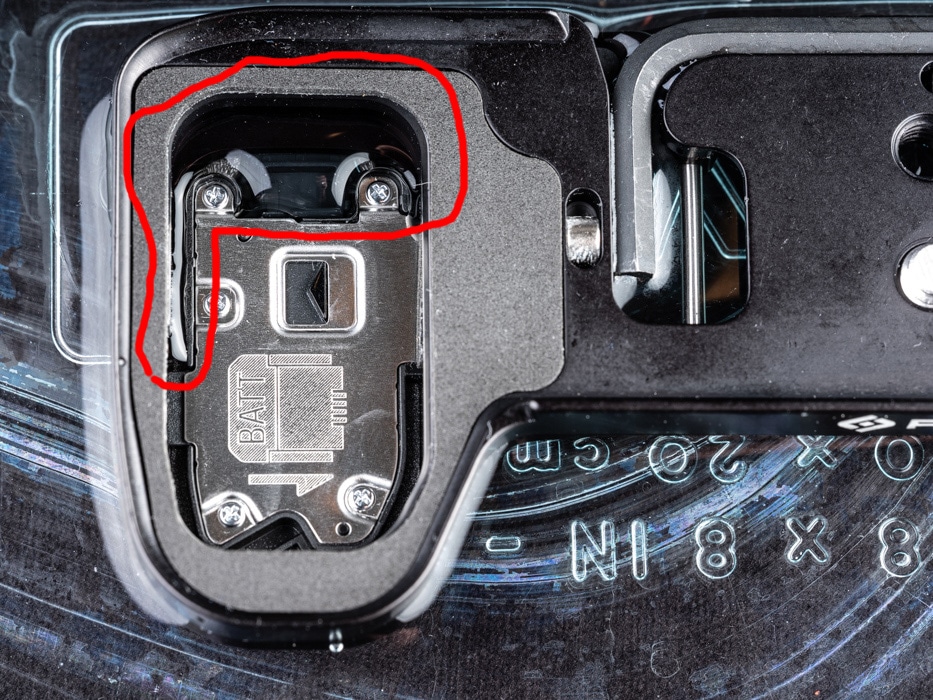This is a continuation of a series of posts on the Sony a7III. You should be able to find all the posts about that camera in the Category List on the right sidebar, below the Articles widget. There’s a drop-down menu there that you can use to get to all the posts in this series; just look for “a7III”.
The battery door of the a7III, and most other a7x cameras, is widely considered to be the camera’s weather-sealing Achilles heel. I wondered if there were some way to test the weather sealing there without destroying a two thousand dollar camera. I came up with one. The Really Right Stuff (RRS) bottom plate for the camera attaches in the following way:
- You take the battery door off the camera
- You mount the plate
- You attach the battery door to the plate.
In the a7III, the pliant (not very pliant, by my estimation) parts of the seal are on the door. The corresponding parts of the camera body are hard plastic. When the door is attached to the RRS plate, it mates with hard anodized aluminum bits that perform the same purpose. It appeared to me that the battery door on the plate would have the same weather resistance as the battery door on the camera, whether or not the plate was attached to the camera. Taking the plate off the camera would allow me to see the entry of moisture.
By the way, you might be wondering how good the weather sealing is between the top of the RRS plate and the battery compartment. It looks to be excellent. There is a broad expanse of soft material that seals with the camera around the battery door.
I set things up this way:
The plate is in a Pyrex dish. The GFX with the 120/4 macro is aimed at the plate. Two 600 watt-second strobes with softboxes light the scene.
Here’s a sequence showing the water entering:
It’s coming through a hole in the baseplate that is part of a mechanism that locks a removable cover in place. The cover is removable so that users can close the battery door and still have an opening to run the cord through when they’re using the dummy battery power supply.
Roger Cicala identified this place as problematical in his a7III teardown.







Mike says
Can you repeat the test with food coloring in the water to make it easier to see?
JimK says
Are you having trouble seeing the water in the pictures posted? Or are you trying to get at something else?
Mike says
A little hard to see, that’s all
JimK says
When I did the addition to the post, I circled the water in red to make it more visible. Did that help?
Haitong Yu says
Another weather sealing problem I have experienced in A7M3 and A7R3 is the top panel. My A7R3’s EVF blacked after shooting in very light drizzle for 15 minutes. My A7M3 also failed but in heavier rain. I have shot my DSLRs (entry or higher level) in similar conditions and everything is fine.
JimK says
That’s one I’m not gonna test!
Danilo Acosta Salvadores says
I’m worried about the a7iii weather sealing and “toughness”, it seems very delicate and not good with water or humidity. I live in a hot, humid city in the caribbean sea (Barranquilla), and the only thing stopping me is that issue. I need a tough camera, what do you think about that issue? I use a Canon 7D, which is really tough but already outdated, so I’m studying my jump for a FFrame.
JimK says
WRT humidity, all but underwater cameras (eg Nikonos) are not airtight, so if the camera is turned off and not generating heat, eventually the interior humidity will match the exterior humidity. So, if you’re concerned mostly about that and not rain, I don’t think that weatherproofing is dispositive. Whether the camera is treated to resist fungus growth would be more important. I have used two a7RIIs in light rain in Alaska with no difficulties. However, the D850 appears to be better sealed, and if rain is your concern, that might be a better choice.
One thing about hot, humid climates: air conditioning is not your friend. Try not to take your camera from air-conditioned locations into warm, humid ones that will cause condensation to form on the cold camera parts inside the camera and lens. If you must do so, put the camera in a baggie and let it warm up before opening the baggie.
CarVac says
I think the second leak point is somewhat unique to these cameras because on my Canon DSLRs the flap for the AC adapter is on the side of the battery compartment instead of on the door on the bottom. It would still leak, but you really need to submerge the bottom of the camera before that becomes the limiting factor.
Alberto says
Hello,
it’s seems that the RRS plate acts as an spacer to retard the access of water till there is enough in the “chamber” that creates. Maybe they need to address a better seal to the hinge when it is moved to the RRS plate. Also, as far as I know, there is a second weak point: camera base plate.- Perhaps if RRS adds a 2 or 3 mm wide seal material on all the perimeter of that baseplate will do.
Regards
JimK says
The RRS hinge seal looks to be better than the Sony in-camera hinge seal, but I can’t test the Sony seal without risking the destruction of the camera. The top of the RRS plate has a very good seal around the battery compartment, but only there.
Tim says
On my RRS plate for the AXM3 / A9 bodies, I noticed that the battery door does not seal nearly as well as the door does when it is connected directly to the camera. With the door closed and locked on the RRS plate, I can clearly see and feel the door move when tapping or pressing down on the down. In fact, there’s a surprising amount of movement, indicating there isn’t a good seal being made at all between the door and the RRS plate. In contrast, with the door connected to the camera and in the locked position, there’s only the tiniest of movement when tapping or pressing on the door, almost imperceptible. Try doing the same with the door on your RRS plate and then on your camera. I suspect you will have the same much looser seal when the door is connected to the RRS plate than with the camera and that that is the cause of the second leak you observed before the water flowed over the hinge.
JimK says
No matter how well the door seals around the edges — and mine appears to seal as well on the plate as the camera — water can get in through the opening around the removable door that’s for the cord when you have a dummy battery installed. I’ll be posting a fix for that.
Tim says
Interesting that your door seals just as well on your plate as it does on your camera. I observed this (really) loose seal on the two RRS plates I’ve had. Agreed that removable part of door for the cord is likely also a problem. Sony probably should have just made a second complete custom door for the dummy battery with cord. Oh well, a bit of cheap tape is working for me, although it’s certainly not satisfying!
Alberto says
I think RRS has some room for improve there and also to provide seal to the bottom plate. On the other hand, it could has a little more height to address the pinky finger problem for users with normal to big hands. Now adds only 11.4mm. 17 or 20 mm would do.
Søren says
I wonder if it would be possible to add ‘something’ to the door to make a better seal?
JimK says
Like this?
https://www.dpreview.com/forums/post/61238962
zeev kirshenboim says
The issue is not just flooding.
I used the Sony a9 in acsmp in Katmai, Alaska. Humidity is high and the temperature flactuate between 5c to 25c. A lit of fog accumulated inside the view finder.
The Nikon D5 and D810 have not shown any sign of being impacted.
It is not enough to seal the top ( against rain)!
I assume that all a7 series will be affected in the same way.
Thanh says
My A7iii got water issue with the top mode-dial. I am not sure how the water could get inside the top dial, but it made the top dial malfunctioned (could not change shooting mode via the dial). I had to go to Sony service and they did something to recover the top dial.
I feel pretty bad with this because I never had such problem with my A7ii under the rain, which I though it got less weather-proof than A7iii.
Could you check how to avoid water leak into the top dial too. Thank you.
JimK says
Sorry, but I have no way of testing the water sealing of the top dials (or any of the dials) without risking damage to the camera. I’m unwilling to take that risk.
Thanh Vu says
That’s understandable, and thank you, JimK.
Just want to warn other A7iii users that the top dial is pretty vulnerable for water leak. And after it got water leak, it’s really hard to dry the water out without professional repair services.